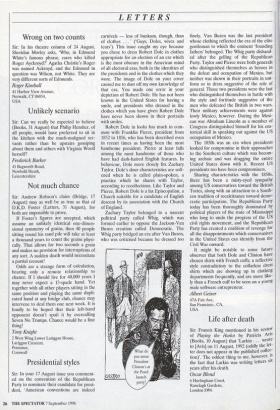Presidential styles
Sir: In your 17 August issue you comment- ed on the convention of the Republican Party to nominate their candidate for presi- dent, 'American conventions are indeed carnivals — less of bunkum, though, than of clothes . ' (`Guys, Doles, wives and tears'). This issue caught my eye because you chose to dress Robert Dole in clothes appropriate for an election of an era which is the most obscure in the American mind of all electoral eras, both in the identities of the presidents and in the clothes which they wore. The image of Dole on your cover caused me to dust off my own knowledge of that era. You made one error in your depiction of Robert Dole. He has not been known in the United States for having a smile, and presidents who dressed in the clothes which you have given Robert Dole have never been shown in their portraits with smiles.
Robert Dole in looks has much in com- mon with Franklin Pierce, president from 1852 to 1856, who has been described even in recent times as having been the most handsome president. Pierce at least falls among the most handsome of those who have had dark-haired English features. In behaviour, Dole more closely fits Zachary Taylor. Dole's dour characteristics are soft- ened when he is called plain-spoken, a practice which he shares with Taylor, according to recollections. Like Taylor and Pierce, Robert Dole is a lax Episcopalian, a Church suitable for a candidate of English descent by its association with the Church of England.
Zachary Taylor belonged to a nascent political party called Whig, which was formed earlier to oppose the Jackson-Van Buren creation called Democratic. The Whig party bridged an era after Van Buren, who was criticised because he dressed too
finely. Van Buren was the last president whose clothing reflected the era of the elite gentleman to which the eminent 'founding fathers' belonged. The Whig party disband- ed after the gelling of the Republican Party. Taylor and Pierce were both generals who distinguished themselves as heroes in the defeat and occupation of Mexico, but neither was shown in their portraits in uni- form or in dress suggestive of the role of general. Those two presidents were the last who distinguished themselves in battle with the style and fortitude suggestive of the men who defeated the British in two wars. Their military achievements were against lowly Mexico, however. During the Mexi- can war Abraham Lincoln as a member of Congress distinguished himself for his ora- torical skill in speaking out against the US occupation of Mexico.
The 1850s was an era when presidents looked for compromise in their approaches to the Southern culture which was becom- ing archaic and was dragging the entire United States down with it. Recent US presidents too have been compromisers.
Sharing characteristics with the 1850s, there has been a misty-eyed sympathy among US conservatives toward the British Tories, along with an attraction to a South- ern tradition of recalcitrance toward demo- cratic participation. The Republican Party today has been thoroughly dominated by political players of the state of Mississippi who long to undo the progress of the US civil rights movement, and the Republican Party has created a coalition of revenge for all the disappointments which conservatives in the United States can identify from the Civil War onward.
It might be notable to some future observer that both Dole and Clinton have chosen shirts with French cuffs; a reflective style contradictory to the collarless dress shirts which are showing up in clothing departments frequently, and are more like- ly than a French cuff to be seen on a young male software entrepreneur.
Albert Geiser
47A Fair Ave, San Francisco , CA, USA


























































 Previous page
Previous page